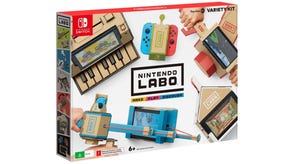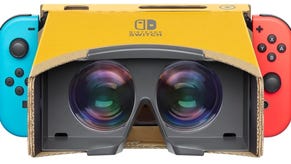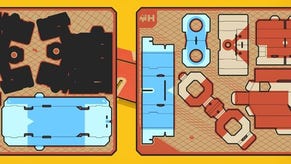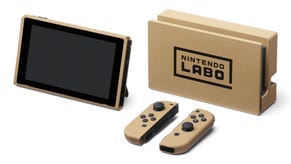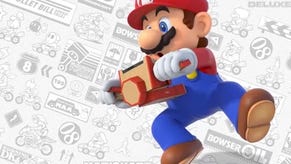Nintendo Labo VR is VR at its simplest - but also its most magical
Goggle cardboard.
The first thought I had when I heard that VR was coming to the Nintendo Switch via the Labo range was probably the same thought that ran through many other minds during the announcement - and that thought was, "well that's not going to work very well." And now I feel silly, because I've honestly been having the loveliest time exploring Nintendo's lo-fi take on virtual reality, surrounded by a pile of peculiar cardboard peripherals. My right eye does feel a little bit weird, but more on that later.
I'd previously been cynical about the Labo range of craft-your-own peripherals, or Toy-Con as Nintendo calls them. £70 for some sheets of cardboard seemed steep to me. But I can tell you right now that each and every Toy-Con was surprisingly fun to make and every time I finished a new build, fresh opportunities for discovery and play emerged - not only from the Labo software but from the Toy-Con themselves. Yes, the materials you build with may only be cardboard, but when it comes down to it, Lego is just bricks made out of a thermoplastic polymer comprised of three monomers. It's not what they're made of that matters, it's what you do with them that counts, and it turns out you can do a hell of a lot with the Labo VR Kit.
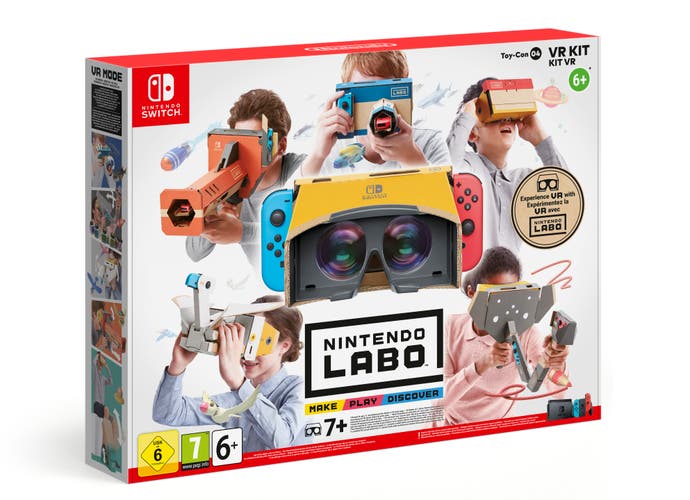
The full Labo VR Kit comes with five Toy-Con and a couple of smaller accessories, each with different build times and minigames associated with them. As with other Labo kits, there's a Switch cartridge included in the package that provides software that will guide you through every step of construction. The animated instructions are easy to follow, lighthearted and interactive - so you can pause, rewind, fast forward and even zoom in to them to check that you're booping your folds in exactly the right way.
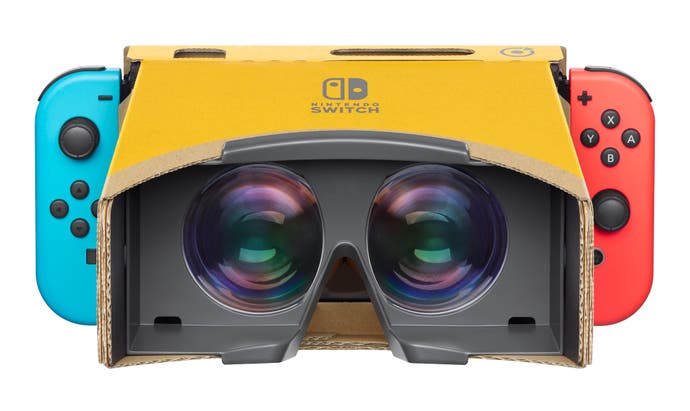
The main component of the kit - and the thing VR enthusiasts like me will be most curious about - is the set of VR Goggles itself. The VR Goggles is one of the simplest builds in the box, made out of only a few pieces of card and a pair of lenses. They're an integral part of all the additional Toy-Con builds though, slotting into them neatly and becoming the sole viewpoint for all your adventures.
As with everything Nintendo, the switch from 2D visuals to 3D is given a little bit of extra flair. A simple tap of a button on the Switch screen stretches and then pulls apart the existing 2D image, satisfyingly snapping it into two perfect circles as if they were liquid held together by surface tension. Once that's done, the Switch can then be inserted into the VR Goggles where the lenses can work their magic.
The lenses (which are encased in a big block of plastic, so you can't adjust the interpupillary distance) magnify the screen, filling your view with a 3D image that, considering the low resolution of the Switch in handheld mode, is bright, relatively clear and gives a good sense of depth and scale. The size of the pixels is a problem for distant objects; any items close to your eyes in Labo VR tend to be relatively crisp and detailed, but the further away they are, the blurrier they get, and the distance at which this starts to happen is relatively short. I think this lack of focus might be the reason why I seem to have strained my right eye using the VR Goggles. Turns out the "take a break" warnings that flash up every 30 minutes or so aren't just for decoration.

The VR Goggles have a few performance issues that VR veterans will be quick to pull up. There's a noticeable drift to the viewpoint after extended periods of play, but that's quick and easy to reset manually by bringing up the menu with a quick 'tap-tap' on the top of the Goggles. Rapidly shaking your head from left to right can also cause onscreen elements to become blurry and stutter, although there's really no need to do this unless you're testing the limits of the console like I was. Framerate-wise, everything seemed to be smooth under normal gameplay circumstances and I didn't notice any stuttering, even in the more intensive VR experiences like Bird Dash and Blaster. There's also limited head tracking. The Switch's gyroscope can handle you looking left and right and up or down, but leaning in or out of the 3D worlds will not register. This is barely an issue, though, as all the games available are stationary affairs that are best played seated anyway.
The biggest stumbling block is the lack of headstrap, meaning you have to physically hold the unit in place, which is uncomfortable over time. Most of the Toy-Con have handles on them which make things a bit more comfortable, and it's worth pointing out that some of the standard VR Plaza minigames can be played with Joy-Con attached to the Switch while it's still in the VR Goggles, which makes it easier to hold. If I had to guess, I'd say that this will be the control method for the upcoming Super Mario Odyssey and Zelda: Breath of the Wild VR updates, but knowing Nintendo they'll incorporate some original twist in there too.
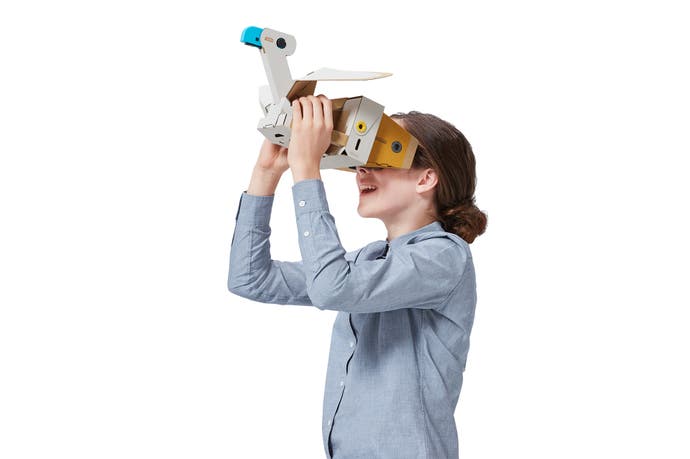
But look, the real people who are going to get the most out of Labo VR aren't going to care about any of that techy nonsense. They're not going to care about IPDs or head tracking. They're going to want to have their child-brains blown by their very first VR adventures - and oh, what adventures await them!
Before I even get onto the signature Toy-Con-focused activities, it's worth noting that there are 64 minigames in the VR Plaza to enjoy. About half are unlocked from the start but more become available with each model you build. Best of all, every single one of the VR Plaza minigames was built using the included Toy-Con Garage VR software, so making your very own VR games with Labo is also within the realms of possibility. Most of these minigames are very short - some of them can literally be completed in seconds - but the huge variety on offer means it'll take a while to get through them all. There are a few short 3D films too - chill experiences like playing fetch with cute dogs or feeding deer in the park.
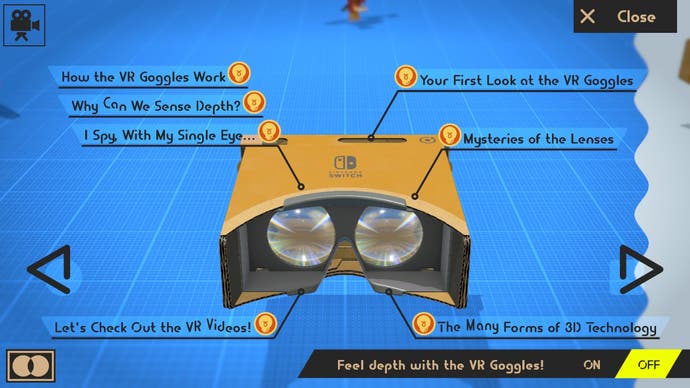
One of my favourite parts of Labo VR Kit is the suite of excellent learning tools built into the Discovery area that aims to teach inquisitive young minds how virtual reality actually works. Gentle, humourous exchanges between a set of friendly characters, punctuated by short video clips and illustrations, teach you everything from the inner workings of each Toy-Con and how they operate in VR to how humans sense depth with binocular parallax and how changes in perspective are achieved in VR. These lessons are short, simple and they're not forced upon you at all, so if you'd rather just play, that's fine - but it's nice to know that they're there and that Nintendo cares enough to educate as well as entertain.
To play the more intricate games in the Labo VR Kit, you're going to need to construct the cardboard Toy-Con, and it is here that Labo elevates the Switch's attempt at VR from a Google Cardboard clone to something completely unique and oh so Nintendo.
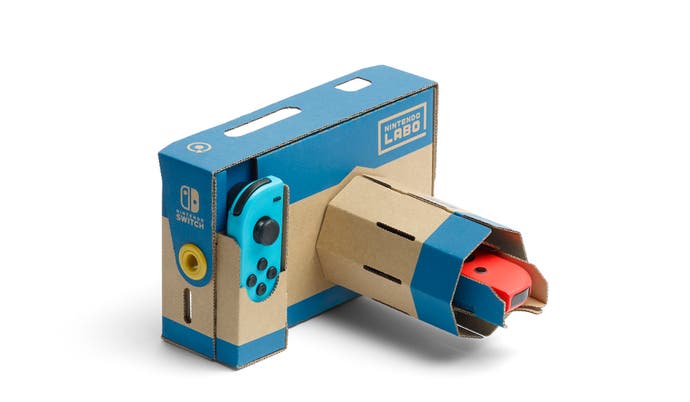
With the Camera Toy-Con built and two Joy-Con inserted, you're automatically transported to a full 360° underwater scene. Here you're told to take photos of the marine animals, and there are many to find above and below the waves. By twisting the lens of the camera you can zoom in and out to compose your ideal shots, and as you do so a cardboard mechanism inside the camera makes a small 'click-clack' sound as the lens twists, a lovely bit of feedback that increases the immersion. A simple cardboard snorkel can also be built that, when tracked by the forward-facing IR Motion Camera on the red Joy-Con, will transform anyone wearing them into a fish with human eyes that appears in the virtual sea. That's just one of many small examples of how Nintendo has injected social aspects into the usually solitary VR experience.
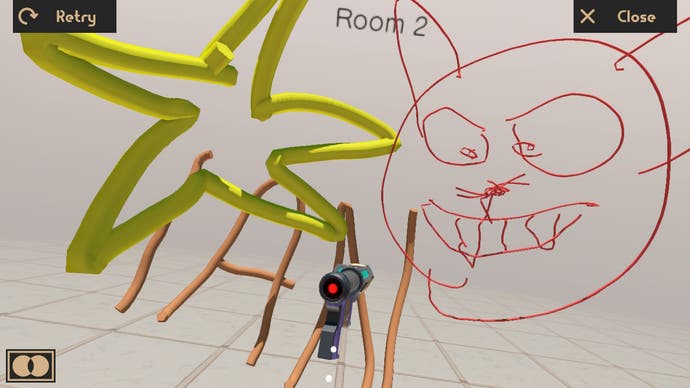
Things get a lot more interactive with the Elephant Toy-Con, my favourite in the pack. The elephant's trunk works like an arm that allows you to reach into the virtual world and interact with it in two extra immersive games. There's Marble Run, an excellent physics-based puzzle game that tasks you with repositioning floating platforms in order to guide balls through hoops, and Doodle, a simple yet fun 3D painting programme with a Guess the Doodle multiplayer game for two players.
The Bird Toy-Con introduces the player to movement within a virtual space; by squeezing a pair of grips on the Toy-Con's body, you can launch a virtual bird into the skies and fly around a beautiful, Mario-esque landscape. The flapping wings built onto the Toy-Con blow a gentle breeze onto your forehead as you propel the virtual bird forwards, once again adding an extra layer of immersion that only Nintendo could deliver.
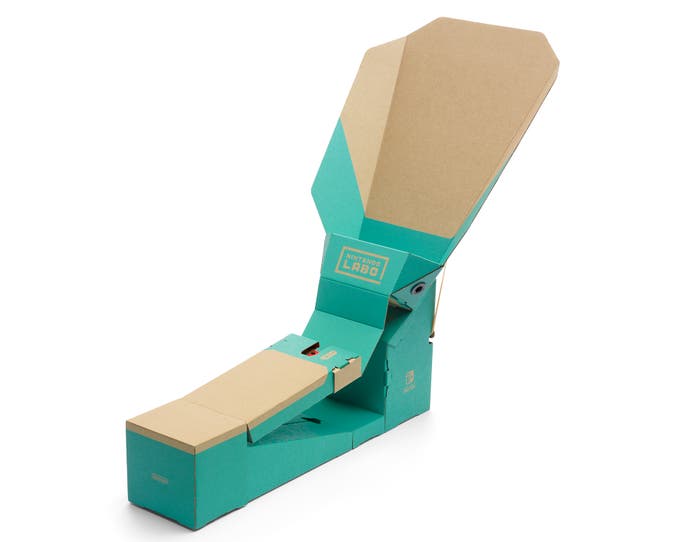
To go faster with the Bird Toy-Con, you can combine it with the Wind-Pedal Toy-Con, which uses a built-in fan to blow big gusts of wind into your face every time you pump it with your foot. This Toy-con is probably the weakest of the bunch, although not physically - it's actually remarkably sturdy for something that boils down to a cardboard version of a kick-drum pedal. There's only one proper game for the Wind-Pedal, if you're not combining it with the Bird Toy-Con to play Bird Dash, and that's called Hop Dodge. A game of Hop Dodge revolves around pressing down on the pedal at just the right time in order to hop a frog over sets of balls, and it quickly becomes repetitive. The way the pedal wafts air back at you gives you a cool feeling of wind rushing past you as you launch yourself into the air and then fall back down, but it gets old fast.
The final Toy-Con in the pack is called the Blaster, and it's an extremely complicated build that can take well over two hours to finish. This is because it has a really clever mechanism inside the barrel that allows you to pump it like a shotgun and lock a special black tube in place. When you pull the trigger, the mechanism releases the black tube, firing it forward inside the Blaster, creating a small bang and simulating the recoil of a gun. The Blaster game is easily the most visually impressive game in the pack, featuring a colourful on-rails shootout with a bunch of squid-like aliens and the occasional towering boss monster.
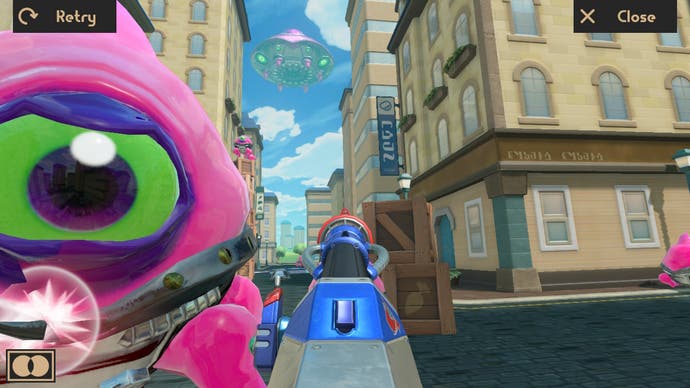
As an introduction to VR, Labo is perfect. Not only is it inventive, educational and fun, it's bursting with all those joyful Nintendo quirks that seem absent from every other VR product on the market (bar maybe Astrobot Rescue Mission on PlayStation VR). Curious kids are sure to be captivated by the huge number of activities on offer as they build, play and hopefully learn a little bit about the science behind VR and the possibilities it presents.
For veterans of virtual reality, the full Labo VR Kit offers few of the jaw-dropping moments they're accustomed to from more professional units, and they'll quite quickly discover the limitations of the Switch's tech and the cumbersome, strap-free design of the headset. But Labo VR Kit isn't really aimed at that those people at all.
If you're a parent who wants to introduce their children to a new frontier in gaming or a previous adopter of Labo who just wants to build more incredibly inventive Toy-Con from the masters of imagination, then I can't recommend the Labo VR Kit highly enough. That old Nintendo magic is everywhere you look, and even the most hardened VR veteran will struggle to suppress a smile at some of the surprises the VR Toy-Con have in store.


